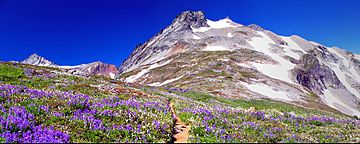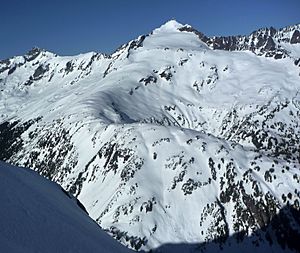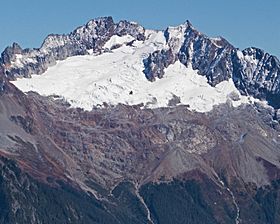Sahale Mountain facts for kids
Quick facts for kids Sahale Mountain |
|
|---|---|

Sahale Arm below Sahale Peak
|
|
| Highest point | |
| Elevation | 8,680+ ft (2,650+ m) NGVD 29 |
| Prominence | 80 ft (20 m) |
| Isolation | 0.34 mi (0.55 km) |
| Parent peak | Boston Peak |
| Geography | |
| Location | North Cascades National Park Chelan / Skagit counties Washington, U.S. |
| Parent range | North Cascades |
| Topo map | USGS Cascade Pass |
| Climbing | |
| First ascent | August 1897 by John Charlton and Albert H. Sylvester |
| Easiest route | Climb, class 3–4, from Cascade Pass |
Sahale Mountain is a tall, rugged mountain found in North Cascades National Park in northern Washington state. Its highest point is called Sahale Peak. This mountain is covered in glaciers. It sits about 0.3 miles south of a taller mountain called Boston Peak. The low area between them is 80 feet lower than Sahale's top.
You can find the Quien Sabe Glacier on the west side of the ridge between Sahale and Boston Peak. The Davenport Glacier is on the east side, in a bowl-shaped area called a cirque. South of the peak is the Sahale Glacier. The Sahale Arm is a ridge that stretches southwest from Sahale Mountain to Cascade Pass. The name Sahale might come from a Native American word meaning "high place," "falcon," or "sacred."
Climbing Sahale Peak
Sahale Peak is famous for its amazing views. Many mountaineers love to climb it. The easiest way to climb Sahale Peak is to follow the Sahale Arm. This path starts from the Cascade Pass Trail and leads to the Sahale Glacier. From the glacier, it's a class 3–4 climb to the very top.
Another way to climb is to go from the Sahale Arm onto the Quien Sabe Glacier. You then climb the glacier to the rocky ridge north of the peak. This climb is also class 3–4. However, it has some loose rocks and is more exposed (meaning there are steep drops nearby). You can reach Cascade Pass and the Sahale Arm from Marblemount in the west. From the east, you can get there by a trail from Stehekin, which goes up the Stehekin River valley.
Weather and Climate
Sahale Mountain is in a marine west coast climate zone. This means it gets a lot of moisture from the ocean. Most weather systems start over the Pacific Ocean. They then travel northeast towards the Cascade Mountains.
When these weather systems reach the North Cascades, the tall peaks force the air upwards. This causes the air to cool and drop its moisture. This process is called Orographic lift. Because of this, the western side of the North Cascades gets a lot of rain or snow. This is especially true during the winter months. In winter, it's often cloudy. But in summer, high-pressure systems over the Pacific Ocean bring clear skies.
How the Mountains Formed
The North Cascades mountains have very rugged shapes. They feature jagged peaks, sharp ridges, and deep valleys carved by glaciers. There are also tall, pointed rocks made of granite. These amazing shapes and big changes in height were created by geological events over millions of years. These events also led to different climates across the range.
The Cascade Mountains began to form millions of years ago. This was during a time called the late Eocene Epoch. The North American Plate was slowly moving over the Pacific Plate. This movement caused many volcanic eruptions. Also, small pieces of the Earth's crust, called terranes, came together. This helped create the North Cascades about 50 million years ago.
Over two million years ago, during the Pleistocene period, glaciers grew and then melted many times. As they moved, these glaciers scraped and shaped the land. They left behind piles of rock debris. The river valleys in the area have a U-shape. This shape is a direct result of these recent glaciers. The rising of the land (called uplift) and cracks in the Earth's crust (called faulting) worked with the glaciers. Together, these processes created the tall peaks and deep valleys we see in the North Cascades today.





